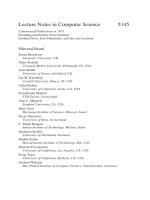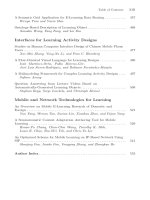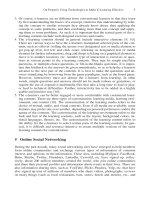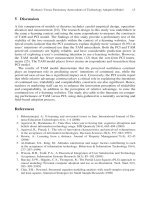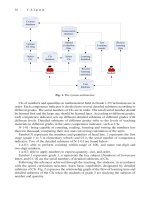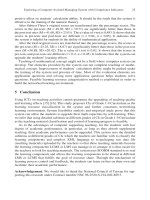Lecture Notes in Computer Science- P66 pptx
Bạn đang xem bản rút gọn của tài liệu. Xem và tải ngay bản đầy đủ của tài liệu tại đây (237.55 KB, 5 trang )
F. Li et al. (Eds.): ICWL 2008, LNCS 5145, pp. 314
–
321, 2008.
© Springer-Verlag Berlin Heidelberg 2008
Methodology for Supporting Novel Model of E-Learning
Platform in Grid Architecture
Tianding Chen
Institute of Communications and Information Technology,
Zhejiang Gongshang University, Hangzhou 310018
Abstract. It combines grid technology with E-Learning, present an E-Learning
architecture based on grid technology to support learning novel mode. By using
Grid Computing technology, this method aims to integrate those unrelated com-
puters in schools to replace high level server as the teaching platforms of
E-Learning. Thus, not only the computer sources in schools can be fully used
and applied, and moreover, constantly sharing the computer sources from other
schools or associations as well as the computing capacities. In this paper, a pro-
totype of E-Learning platform using grid environment is proposed, built up
using a number of open source E-Learning software in a heterogeneous envi-
ronment. In the future, using grid technology on E-Learning might be a new
scheme. We also expect the outcome and experiences of this research can pro-
vide reference to the schools that wish to develop E-Learning environment for
saving the cost and time in developing a similar system.
1 Introduction
Grid technology was originally conceived to provide support for applications belong-
ing to scientific domains. However, the grid is currently embarked on a maturation
process derived from the definition of the Open Grid Services Architecture (OGSA)
[1] which could allow the expansion of grid technology within new domains such as
business and education. At present, education and collaboration are emerging as very
important application fields of grid technologies. The use of grid technologies may
enable access to large amounts of heterogeneous resources that can be employed for
educational purposes. This new scenario is called E-Learning Grid or Learning Grid
[2][3][4][5][6].
In recent years, with the rapid development in communication and network tech-
nologies, E-Learning has been popularized and become one of the most popular
teaching methods in educational community. Along with the gradual improvements
found in network bandwidth and quality, real-time transmission of high-quality video
and audio has become possible and true reality. Because of these major transitions,
conventional methods of school education have also followed this trend.
E-Learning utilizes electronic devices to assist the education or training process,
taking advantage of the internet or any other communication channel to connect other
devices, to deliver information and knowledge. This model of learning has many
advantages with respect to traditional models: a better interaction between the learner
and the learning resources he uses, i.e., the learning is not passive; Learning can
happen anytime and anywhere, i.e., there are not boundaries tied to time and place; A
Methodology for Supporting Novel Model of E-Learning Platform in Grid Architecture 315
tutor, or learner himself, is able to monitor the progress and to customize the learning
experience basing on learner skills and preferences.
In E-Learning research, it is a crucial problem the support of learning in scalable, open,
dynamic and heterogeneous environments. The scenario is a large scale and connected
environment of Learning Management Systems, Learning Content Management Systems
and virtual classroom systems of different organizations. Grid computing has emerged as
an important new field, distinguished from conventional distributed computing by its
focus on large-scale resource sharing, innovative applications and, in some cases, high-
performance orientation [7]. Grid technology address issues related to access provision-
ing coordinated resource sharing and problem solving in dynamic, multi institutional
virtual organization [8]. By adopting grid technology, it is possible a wide-scale learning
resource sharing in heterogeneous and geographically distributed environments, the im-
plementation of learning organizations in which different actors (teachers, learners),
sharing a common target, are able to cooperate to obtain a result.
2 E-Learning Systems and Grid Computing
With the rapid growth of the Internet and digital technologies, the web has become a
powerful, global, interactive, dynamic, economic, and democratic medium of learning
and teaching at a distance [9]. E-Learning is the unifying term to describe the fields of
online learning, web-based training, and technology-delivered instruction.
Rosenberg[10] defines E-Learning have three fundamental criteria: a E-Learning is
networked, which makes it capable of instant updating, storage/retrieval, distribution
and sharing of instruction or information; It is delivered to the end-user via a com-
puter using standard Internet technology; It focuses on the broadest view of learning –
learning solutions that go beyond the traditional paradigms of training.
General E-Learning systems have four components: People, Authoring System, Run-
Time System, and Learning Management System (LMS) [6]. People in these systems
are the learners and authors, while others may include trainers and administrators. Au-
thors (which may be teachers or instructional designers) create content, which is stored
under the control of a LMS, and typically in a database. Existing content can be up-
dated, and it can also be exchanged with other systems. A LMS is managed under the
control of an administrator, and it interacts, with a run-time environment which is ad-
dressed by learners, who in turn may be coached by a trainer. These components of an
E-Learning system can be logically and physically distributed.
In current incredibly complex world of computational power, very high speed ma-
chine processing capabilities, complex data storage methods, next-generation telecom-
munications, new generation operating systems and services, and extremely advanced
networking services capabilities, we are entering a new era of computing-Grid Comput-
ing [11]. Grid computing has emerged as a framework for supporting complex compila-
tions over large data sets. In general, grids enable the efficient sharing and management
of computing resources for the purpose of performing large complex tasks [12].
Although many academies have now adopted E-Learning for teaching, the software
and hardware facilities that the academies use are very different. It has become a
cause of major difficulties in sharing the teaching resources with one another. The
technique of Web Services can integrate the different information system within the
316 T. Chen
Fig. 1. The Grid computing infrastructure
Grid to solve the above mentioned problem. Therefore, the concept of this research is
based on integrating Grid Computing with Web Services to build up an E-Learning
platform [13]. Figure 1 shows the concept of grid computing.
3 Proposed E-Learning Grid Architecture
The architecture contains five layers from bottom to up, as shown in Figure 2 [14].
The infrastructure layer, at the lowest layer, supports basic networking environment,
Fig. 2. An E-Learning Grid Architecture
Methodology for Supporting Novel Model of E-Learning Platform in Grid Architecture 317
including computing devices, networking and networking protocols etc. Secondly, the
basic service oriented architecture for implementing the basic web services related
protocols such as XML, UDDI/SOAP/WSDL etc. This layer provides the elementary
connectivity, interoperation, reliability and flexibility for the layers on top of it. As
next layer, the grid middleware layer is the core of the architecture where the basic
grid problems such as distribution, dynamic, open and cross-organization are re-
solved. The content layer is on top of grid middleware layer to store all of learning
contents in our platform. At last, the learning grid portal supports single user sign on
the system. In next subsections, brief introduction of these layers will be discussed.
Grid Middleware Layer is a crucial layer to build a grid environment and should be
on existing OGSA compliant middleware such as Globus Toolkit 4 (GT4). The
Globus project provides open source software toolkit that can be used to build compu-
tational grids and grid-based applications [15]. It allows sharing of computing power,
databases, and other resources securely across corporate, institutional and geographic
boundaries without sacrificing local autonomy. It implements services for Security
Services, Resource Management, Information Services and Data Management in the
grid. The main functions of them are listed below.
(1) Security Services
(2) Resource Management
(3) Information Services
(4) Data Management
Content Layer is on top of grid middleware layer to store all of contents in our plat-
form [16]. As above mentioned an E-Learning system needs a Learning Management
System to store and manage its teaching content. However, every LMS platform runs
its own learning materials, which cannot be exchanged with those of other LMSs. To
deal with this problem, the U.S. government launched the Advanced Distributed
Learning Initiative (ADL) [17] is unifying E-Learning specifications emerging from
the international standards organizations into a single specification referred to as the
Sharable Content Object Reference Model (SCORM). SCORM aims to establish a
mechanism for repeated use and sharing of courseware as a way to reduce the time
and cost of developing courseware and to make courseware reusable and acceptable
to different LMSs.
Learning Gird Portal is the unified entry for all grid platform users. Users from dif-
ferent organizations who logon it could share learning resources without knowing
where they come from. Moreover, the portal is responsible for assisting authenticated
users when operating within the grid environment.
4 Optimization on Grid Portal Structure
In a grid organization, the grid portal allows communication between the outside
world and the grid. The major function is to provide users with a web-based interface
for the grid service and resources. To make the grid portal run more efficient way, we
use the web mining technology to adjust its framework. To make it congregate users’
needs. Web mining is a type of application of data mining and it is categorized into
“web content mining” and “web usage mining”. Web content mining deals with sur-
veying the contents of the web and it is mainly applied to analyzing web contents and
318 T. Chen
reinforcing web-searching capability, such as a search engine. Web usage mining
mainly deals with analyzing the web users’ browsing behavior through web log, so
that the web administrator will become aware of the operation of the website before
modifying the system, for the purpose of more efficient operation [18].
Web Usage Mining suggests analysis of user’s browsing behavior through the web
log. It enables the web administrator to be aware of the operation of the website be-
fore modifying the framework, for the purpose of more efficient operation. Its appli-
cation comes as follows:
(1) Analysis of web flow.
In the web log, the title and size of a specific web and a specific access are duly
registered and pattern for the web flow. In the [19] study, variation of web flow in
each day of the week is registered in the web log. Analysis of it will become more
applicable on the adjustment and planning of network bandwidth.
(2) Improvement of web accessibility.
By analyzing the web log, we have come to realize what popular websites and files
are received more in an access rate. Consequently, we can place those files in the Web
Proxy server or cache server. In the [20] study, we can analyze the web log and make
a forecast of the popular web pages to decide on its priority of the pages in Cache.
(3) Analysis or forecast of browsing behavior.
This is a common subject being studied in Web Usage Mining. Robert Cooley et.
al. [21] is one of the few experts that introduced the idea. Other studies aim to im-
prove or propose new algorithmic methods [22] [23] for more efficient analysis. On
the other hand, the web mining tool WUM [24] used in this study is theoretically
based on aggregate tree, and MINT language that resembles SQL is used for analysis
of the web before reaching to the patterns that we are interested in.
Data obtained through WUM analysis can be taken as a pattern, which comes from
a kind of a rule. An example is that the browse from page A, page B to page C must
follow a number of rules. To locate the most beneficial one, other methods are
needed. In this case, we opt for the Greedy Algorithm.
Greedy Algorithm is simply understood as: When we have a number of options, we
will usually select the most beneficial one at sight [25]. Figure 3 shows a simple route
selection.
Fig. 3. A simple route selection
Suppose we are to choose the most popular route from V
0
to V
3
, Greedy Algorithm
would suggest 5 + 10 + 7 = 22, which is the common one. This can not be an easy job
every time. The following Figure 4 explains why.

